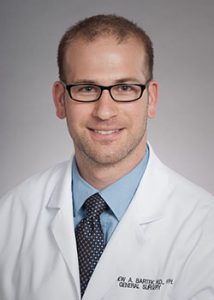Dr. Matthew Bartek Published “Improving Operating Room Efficiency: Machine Learning Approach to Predict Case-Time Duration” in JACS
November 8, 2019
 Dr. Matthew Bartek, General Surgery Chief Resident, published “Improving Operating Room Efficiency: Machine Learning Approach to Predict Case-Time Duration” in the Journal of the American College of Surgeons.
Dr. Matthew Bartek, General Surgery Chief Resident, published “Improving Operating Room Efficiency: Machine Learning Approach to Predict Case-Time Duration” in the Journal of the American College of Surgeons.
Dr. Bartek details “We started with a simple question: “Can we accurately predict how long an operation will take using preoperative information?” Answering this question has broad-reaching implications, given that operating room procedures account for a large portion of hospital revenue and cost. Our interdisciplinary team was a collaboration among anesthesiologists, data scientists, and residents in surgery and anesthesia which allowed us to address the problem with varied perspectives in mind. Using a novel institutional dataset provided by the Center for Perioperative & Pain Initiatives in Quality Safety Outcome (PPiQSO) at the University of Washington (UW), we modeled case-time duration, that is “wheels-in to wheels-out,” for all planned operations at the UW over 4 years from January 2014 until December 2017. The novelty of our approach was that we restricted the prediction model to only those data available before the time of scheduling and we used a machine learning algorithm called XGBoost to generate several models against which we compared surgeons’ own estimates, the scheduling standard. There was nearly a 25% improvement in accuracy (from 32% to 39%) when we modeled surgeons individually using the machine learning algorithm using a variety of patient, procedure and personnel information.
The strength of this study was our team: we worked collaboratively, meeting weekly to share ideas, review progress, and adjust our approach. In addition, practical implementation remained a focus of this project and Dr. Bala Nair, the senior author of the study, is working to create systems to improve case-time estimates at the University of Washington and beyond. As noted above, we started with a simple question but answering it involved complex data collection, modern statistical techniques, and perhaps most importantly, a multi-disciplinary collaboration.”
